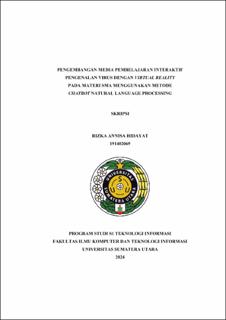| dc.description.abstract | Biology is one of the important subjects in high school that studies life and living
organisms, including viruses. Virus material is often considered difficult by students
due to its microscopic and complex nature. This study aims to develop interactive
learning media that facilitates students' understanding of viruses by utilizing Virtual
Reality (VR) technology and a chatbot based on Natural Language Processing (NLP).
This learning media is designed to provide a more immersive and interactive learning
experience. The NLP chatbot is used to provide responsive and personalized
interactions for users, allowing students to ask questions and receive direct
explanations in the VR environment. The VR technology in this study is used to visualize
viruses associated with six types of diseases, namely smallpox, influenza, hepatitis,
coronavirus, Ebola, and HIV in the form of 3D objects. The creation of 3D objects uses
Unity 3D, implemented with the Virtual Box tool. The results of the study show that the
use of interactive learning media based on VR can significantly improve students'
understanding of virus material. Testing involved 30 student respondents and one high
school biology teacher respondent using the Likert scale calculation, a self-report
measurement tool, which showed that 88.2% of all respondents provided positive
feedback on this media in terms of learning effectiveness, application use, and learning
motivation. Additionally, 35.16% and 47.9% of respondents strongly agreed on the
satisfaction with all aspects of the application's UI and UX assessment. This study
concludes that the development of interactive learning media based on VR with the NLP
chatbot method is a potential innovation to be applied in high school biology education,
providing an effective solution in facing the challenges of learning in the digital era. | en_US |


